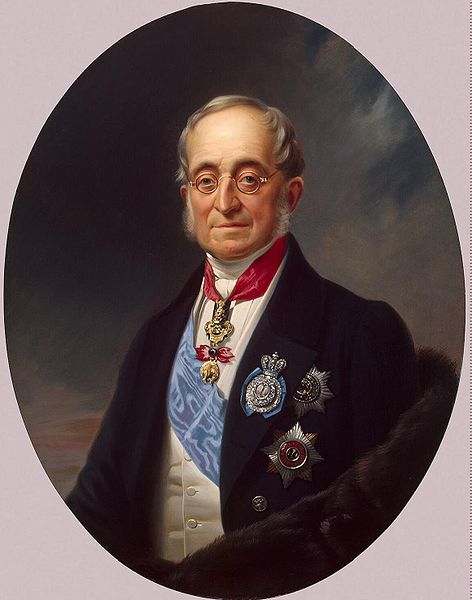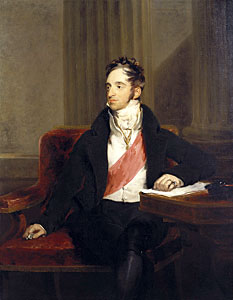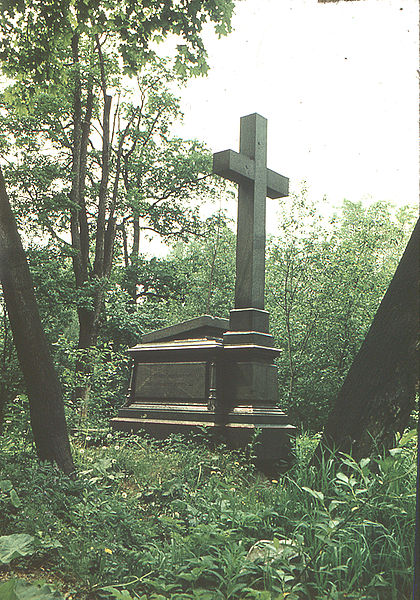<Back to Index>
- Apothecary Michel de Nostredame (Nostradamus), 1503
- Painter Pierre Puvis de Chavannes, 1824
- Minister of Foreign Affairs Karl Robert Nesselrode, 1780
PAGE SPONSOR



Baltic-German Count Karl Robert Nesselrode, also known as Charles de Nesselrode, (Lisbon, Portugal, December 14, 1780 - March 23, 1862) was a Russian diplomat and a leading European conservative statesman of the Holy Alliance. His autobiography was published posthumously in 1866.
He was born in Lisbon, Portugal, where his father (d. 1810), a count of the Holy Roman Empire, was the ambassador of the Russian tsar. In deference to his mother's Protestantism he was baptized in the chapel of the British Embassy, thus becoming a member of the Church of England. Nesselrode's Germanic roots were emphasized by his education in a Berlin gymnasium, his father having been appointed ambassador to the Prussian court about 1787.
At the
age of 16 he entered the Russian Navy where, with his father's
influence, he secured the position of naval aide-de-camp to Tsar Paul. He
then moved to the army, and entered diplomatic service under Paul I's
son and successor, Tsar Alexander I.
He was attached to the Russian embassy at Berlin, and transferred
thence to the Hague.
In
August 1806, Nesselrode received a commission to travel in southern
Germany to report on the French troops there; he was then attached as
diplomatic secretary to Generals Kamenski, Buxhoewden and Bennigsen in succession. He was
present at the inconclusive Battle of Eylau in January 1807, fought by
Count Von Bennigsen and assisted at the negotiations of the Peace of Tilsit,
(July 1807), whereby Spanish Bonapartist Diego Fernandez
de Velasco, (deceased in Paris in the exile in 1811), 13th Duke
of Frías, congratulated and seated at table with Napoleon I.
Nesselrode became State Secretary in 1814 and was the head of Russia's official delegation to Congress of Vienna, but for the most part Alexander I acted as his own foreign minister. In 1816, Nesselrode became Russian foreign minister, sharing influence with Count Ioannis Kapodistrias until the latter's retirement in 1822. For forty years, Nesselrode guided Russian policy and was a leading European conservative statesman of the Holy Alliance. Between 1845 and 1856, he served as Chancellor. As Minister of Foreign Affairs in 1824, he was a plenipotentiary during negotiations with the United States in defining the boundary between Russian America and the American claims known as the Oregon Country, which was resolved with the Russo-American Treaty of 1824, and a parallel treaty with Britain concerning British claims which overlapped on those of the US. A century later in 1924, Mount Nesselrode in the Boundary Ranges of the Alaska - British Columbia boundary was named for him.
In 1849 Nesselrode sent Russian troops to aid Austria in putting down the Hungarian revolution led by Lajos Kossuth.
One frequently overlooked facet of his activity involved Nesselrode's attempts to penetrate Japan's self-isolation. In 1853 he dispatched Yevfimy Putyatin with a letter to the Shogun; Putyatin returned to St. Petersburg with the favorable Treaty of Shimoda.
Nesselrode's efforts to expand Russia's influence in the Balkans and Mediterranean led to conflicts with Turkey, Britain, the then Kingdom of Sardinia, the then Duchy of Savoy and France, allied in the Crimean War (1853 – 1856). Britain and France were concerned by Russia's growing influence and were determined to support Turkey and so restrict Russia.